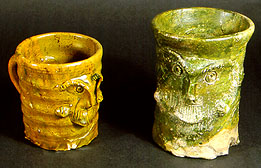 |
Ashmolean Museum of Art and Archaeology | The Collections: | ||
| PotWeb: | Ceramics
online @ the Ashmolean Museum |
• | Early Europe & Near East | |
| • | Classical to Medieval | |||
| • | Europe from 1500 | |||
| • | Oriental & Islamic | |||
| Fingerprints of the maker |
| Smart potters succeed | |
| The repertoire of vessels and their distribution patterns reflect the economic drive of a production centre. Rising incomes in the thirteenth century encouraged the demand for `packaged' foods, such as butter in pots. By anticipating consumer demand with innovation and marketing, certain pottery workshops succeeded. Such an example is the production centre at Brill/Boarstall, which dominated the local ceramic market for some 500 years. |  Novelties
captured the townsmen's imagination
Novelties
captured the townsmen's imagination |
| The social status of the potters and their families can be explored through interpreting the processes of imitation, innovation and `style drift'. This helped to spread new designs and new products. Conclusions from such studies can be substantiated by the techniques of ethnoarchaeology in modern craft-based communities. Our understanding of the production techniques can be explored by means of field experiments and reconstruction. | |
|
How were pots fired? |
Fingerprints ... | Bibliography |
|
© Copyright University of Oxford, Ashmolean Museum, 2000 The Ashmolean Museum retains the copyright of all materials used here and in its Museum Web pages. last updated: jcm/27-jun-2000 |